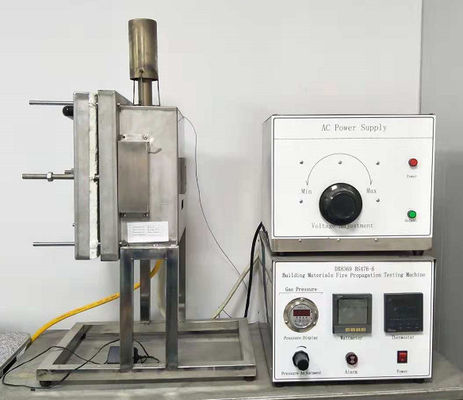Product Overview:
1. BS 476-6 is a test method for measuring the flame propagation characteristics of materials, mainly used to evaluate the fire resistance performance of walls and ceilings, and provides test results. As an indicator of flame propagation.
2. During the experiment, the sample was exposed to a tubular torch with a heat release of 530 J/S. During the experiment, the sample was exposed to a tubular torch with a heat release of 530 J/S. After 5 minutes of testing, the power was reduced to 1500 W and the power was not changed until the experiment was completed. The total testing time was 20 minutes.
3. In order to evaluate the flame propagation characteristics of the materials tested in BS476-6, thermocouples continuously recorded the chimney temperature and room temperature difference, and compared them with the calibration curve. The calibration curve was measured using the same method based on the specified density of asbestos cement board.
4. The temperature difference values of two curves measured simultaneously were compared. Take the temperature difference value every 30 seconds during the first three minutes of the test, and every minute for the next 4-10 minutes. In the last 11-20 minutes, the temperature difference value was taken every two minutes, and the flame diffusion index for these three stages was calculated according to the formula.
5. I is the sum of the three flame spread indices. The higher the value of I, the lower the flame retardant of the material. For grade 0 materials, I ≤ 12
Reference standard:
BS 476 Part 6 A1: 2009: Standard for flame retardancy and fire resistance testing of building materials;
GB/T 17658-1999: Flame retardant wood combustion performance test "Fire propagation test method"
Product features:
1. Stainless steel cabinet support frame;
2. Calcium silicate burner;
3. These three samples are all wrapped in stainless steel;
4. Two sets of 1000 W quartz radiation devices provide thermal radiation to the samples;
5. The T-shaped burner provides flame combustion for the sample;
6. Thermocouples continuously record temperature and room temperature difference values in the chimney;
7. Automatically control output power based on time testing;
8. Computers automatically process data and print test reports.
Installation requirements:
1. Environmental temperature: operating from 10 ℃ to 35 ℃;
2. Natural gas supply: The gas supply standard specified in the standard is the standard test gas G112, as specified in BS 4947;
3. Gas flow rate: The gas flow rate of the burner can be adjusted from 0 to 5 n/minute
4. Voltage: 230V, 10A
5. Pressure: 1 kpa

 Your message must be between 20-3,000 characters!
Your message must be between 20-3,000 characters! Please check your E-mail!
Please check your E-mail!  Your message must be between 20-3,000 characters!
Your message must be between 20-3,000 characters! Please check your E-mail!
Please check your E-mail! 



